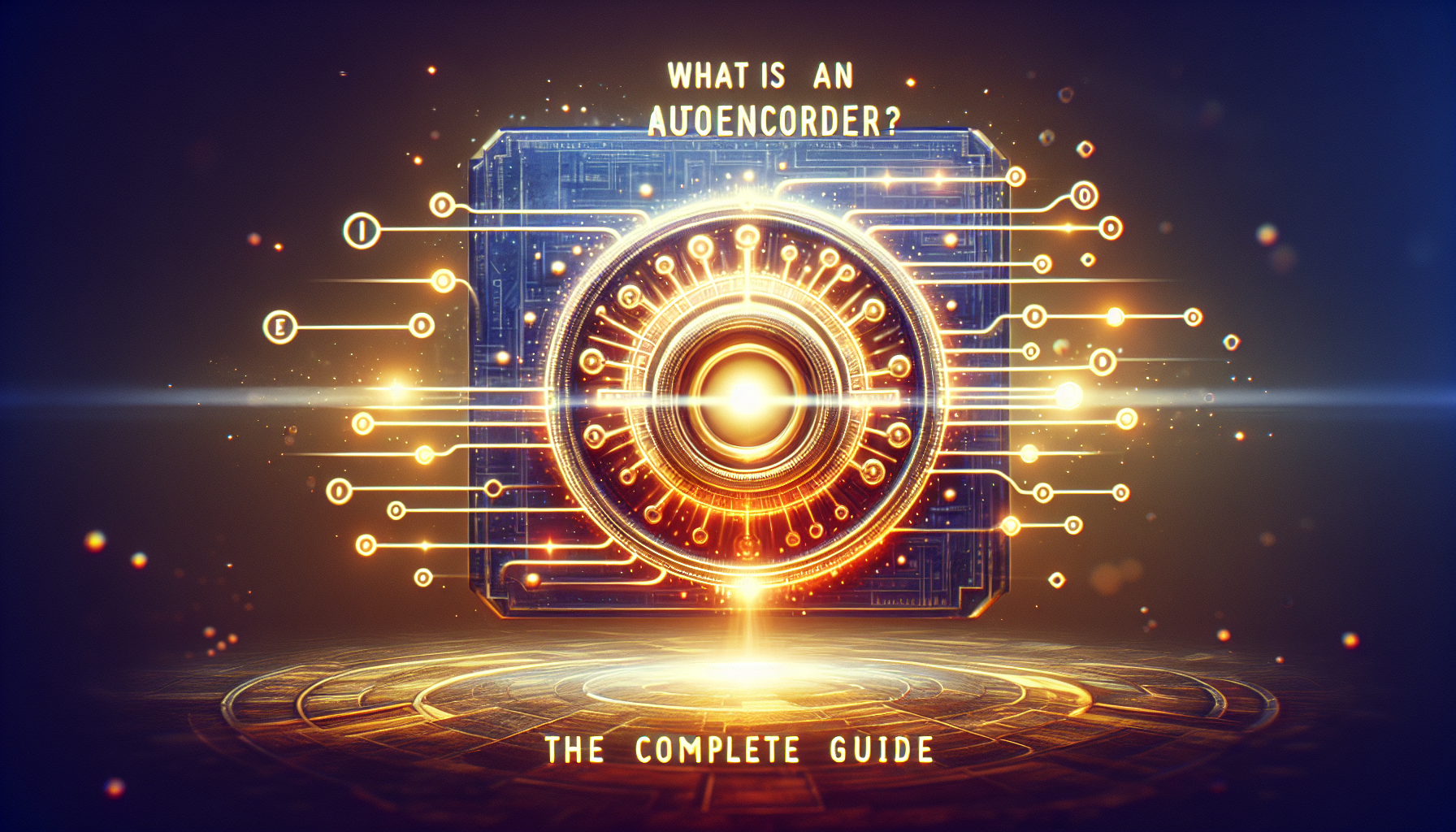Autoencoders, or autoencoders in English, position themselves as powerful tools in the field of machine learning and artificial intelligence. These special neural networks are used for dimension reduction, anomaly detection, data denoising, and more. This article provides an introduction to this fascinating technology, highlighting its working principle, its applications and its growing importance in research and industry.
What is an autoencoder?
A autoencoder is a type of artificial neural network used for unsupervised learning. The main goal of an autoencoder is to produce a compact representation (encoding) of a set of input data and then reconstruct the data from this representation. The idea is to capture the most important aspects of the data, often for dimensionality reduction. The structure of an autoencoder is typically composed of two main parts:
- Encoder (Encode): This first part of the network is responsible for compressing the input data into a reduced form.
- Decoder (Decode): The second part receives the compressed encoding and attempts to reconstruct the original data.
How do autoencoders work?
The operation of autoencoders can be described in several steps:
- The network receives data as input.
- The encoder compresses the data into a feature vector, called the code or latent space.
- The decoder takes this vector and tries to reconstruct the initial data.
- The quality of the reconstruction is measured using a loss function, which evaluates the difference between the original inputs and the reconstructed outputs.
- The network adjusts its weights via backpropagation algorithms to minimize this loss function.
Through this iterative process, the autoencoder learns an efficient representation of the data, with an emphasis on preserving the most important features during the reconstruction process.
Practical applications of autoencoders
Autoencoders are very versatile and can be applied in several areas:
- Dimensionality Reduction: Like PCA (Principal Component Analysis), but with non-linear capacity.
- Denoising: they are able to learn to ignore the “noise” in the data.
- Data Compression: they can learn encodings that are more efficient than traditional compression methods.
- Data generation: by navigating the latent space, they allow the creation of new data instances that resemble the original entries.
- Anomaly Detection: Autoencoders can help spot data that does not fit the learned distribution.
In short, the ability of autoencoders to discover and define meaningful characteristics of data makes them a must-have instrument in any AI practitioner’s toolkit.
Autoencoder: encoding, bottleneck and decoding

Coding
Encoding, or the encoding phase, involves transforming the input data into a compressed representation. The initial data, which may be large, is fed into the autoencoder network. The layers of the network will gradually reduce the dimensionality of the data, compressing essential information into a smaller representation space. Each layer of the network is composed of neurons which apply non-linear transformations, for example, using activation functions such as ReLU or Sigmoid, to arrive at a new representation of the data which retains the essential information .
Bottleneck
The bottleneck is the central part of the autoencoder where the data representation reaches its lowest dimensionality, also called code. It is this compressed representation that retains the most important characteristics of the input data. The bottleneck acts as a filter forcing the autoencoder to learn an efficient way to condense the information. This can be compared to a form of data compression, but where the compression is learned automatically from the data rather than being defined by standard algorithms.
Decoding
The decoding phase is the step symmetrical to the coding, where the compressed representation is reconstructed towards an output which aims to be as faithful as possible to the original input. Starting from the bottleneck representation, the neural network will gradually increase the dimensionality of the data. This is the reverse process of coding: successive layers reconstruct the initial characteristics from the reduced representation. If decoding is efficient, the output of the autoencoder should be a very close approximation of the original data.
In unsupervised learning, autoencoders are particularly useful for understanding the underlying structure of data. The effectiveness of these networks is measured not through their ability to perfectly reproduce inputs, but rather through their ability to capture the most salient and relevant attributes of the data in code. This code can then be used for tasks like dimension reduction, visualization, or even preprocessing for other neural networks in more complex architectures.
Practical applications and variations of autoencoders

L’autoencoder, a key component in the arsenal of deep learning powered by Artificial Intelligence (AI), is a neural network designed to encode data into a lower-dimensional representation and decompose it in such a way that a relevant reconstruction is possible. Let’s examine them practical applications and the variants that have emerged in this fascinating field.
Practical applications of autoencoders
Autoencoders have found their way into a multitude of applications due to their ability to learn efficient and meaningful representations of data without supervision. Here are some examples:
Dimensionality reduction
Like PCA (Principal Component Analysis), autoencoders are frequently used for dimensionality reduction. This technique makes it possible to simplify data processing by reducing the number of variables to take into account while preserving most of the information contained in the original dataset.
Noise Cancellation (Denoising)
With their ability to learn to reconstruct input from partially destroyed data, autoencoders are particularly useful for noise cancellation. They manage to recognize and restore useful data despite the interference of noise.
Data Compression
By learning to encode data into a more compact form, autoencoders can be used for data compression. Although they are not yet widely used for this purpose in practice, their potential is significant, especially for compressing specific data types.
Data generation and imputation
Autoencoders are able to generate new data instances that resemble their training data. This ability can also be used to imputation, which involves filling in missing data in a dataset.
Autoencoder variants
Beyond the standard autoencoder, various variants have been developed to adapt to the specifics of the data and the tasks required. Here are some notable variations:
Variational Autoencoders (VAE)
THE Variational Autoencoders (VAE) add a stochastic layer which allows data to be generated. VAEs are particularly popular in the generation of content, such as images or music, because they make it possible to produce new and varied elements that are plausible according to the same model.
Sparse Autoencoders
THE sparse autoencoders incorporate a penalty that imposes limited activity in hidden nodes. They are effective in discovering distinctive characteristics of data, which makes them useful for classification and the anomaly detection.
Denoising Autoencoders
THE denormalized autoencoders are designed to resist the introduction of noise into the input data. They are powerful for learning robust representations and for data preprocessing before performing other machine learning tasks.
Sequential Autoencoders
THE sequential autoencoders process data organized in sequences, such as text or time series. They often use recurrent networks like LSTM (Long Short-Term Memory) to encode and decode information over time.
How to train an autoencoder and code examples

The training of a autoencoder is an essential task in the field of machine learning for dimensionality reduction and anomaly detection, among other applications. Here we will see how to train such a model using Python and the library Keras, with code examples that you can test and adapt to your projects.
Process of training an autoencoder
To train an autoencoder, one typically uses a loss metric, such as mean square error (MSE), which measures the difference between the original input and its reconstruction. The goal of training is to minimize this loss function.
Example code with Keras
Here is a simple example of training an autoencoder using Keras:
from keras.layers import Input, Dense
from keras.models import Model
# Entrance size
# Dimension of the latent space (feature representation)
encoding_dim = 32
# Definition of encoder
input_img = Input(shape=(input_dim,))
encoded = Dense(encoding_dim, activation='relu')(input_img)
# Definition of decoder
decoded = Dense(input_dim, activation='sigmoid')(encoded)
# Autoencoder model
autoencoder = Model(input_img, decoded)
# Model compilation
autoencoder.compile(optimizer='adam', loss='binary_crossentropy')
# Autoencoder training
autoencoder.fit(X_train,
epochs=50,
batch_size=256,
shuffle=True,
validation_data=(X_test, X_test))
In this example, `X_train` and `X_test` represent the training and test data. Note that the autoencoder is trained to predict its own input `X_train` as output.
Tip for a good workout
Use techniques like cross validation, there batch normalization and the callbacks of Keras can also help improve the performance and stability of the autoencoder drive.
Applications of autoencoders
After training, autoencoders can be used to:
- dimensionality reduction,
- anomaly detection,
- unsupervised learning of descriptors useful for other machine learning tasks.
To conclude, training an autoencoder is a task that requires understanding of neural network architectures and experience in fine-tuning hyperparameters. However, the simplicity and flexibility of autoencoders make them a valuable tool for many data processing problems.

Leave a Reply